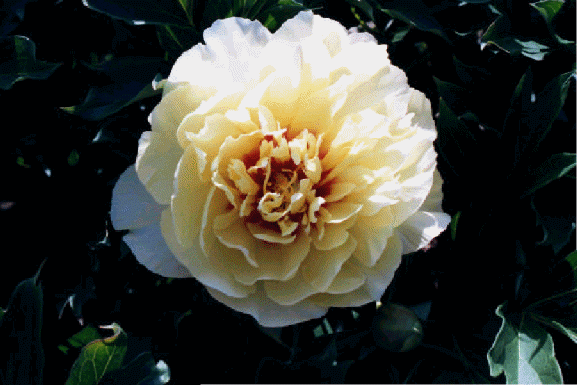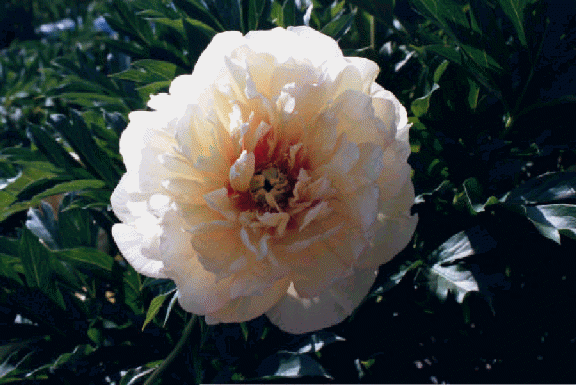
Paeonia Newsletter [vol.31/2]/Paeonia newsletter
Volume 31, No. 2
Summer 2001
Editor and Publisher:
Donald R. Smith 46 Exeter Street W. Newton, MA 02465
e-mail: paeonianews@aol.com Web site: paeonianewsletter.com
Subscription Rates:
U.S.
5 yrs. --$25. 10 yrs. --$45.
Outside U.S.
$35. $65.
Table of Contents:
Intersectional Hybrids from the
Reciprocal Cross................................ P-1
What a Difference a Year Makes........ P- 3
Photos of several (M. Wash, x Golden Era) hybrids.................................. P-
Starting with this issue, Paeonia will be available on-line at Paeonianewsletter.com
If you wish to be notified by e-mail when a new issue has been published, please send me your e-mail address at paeonianews@aol.com
Intersectional Hybrids from the Reciprocal Cross
by D. R. Smith
Producing intersectional hybrids from the reciprocal cross (tree peony x herbaceous peony) is exceedingly difficult. After many years and literally hundreds of seeds, I have only two surviving plants that are genuine reciprocal hybrids. On the other hand, I have produced hundreds of true hybrids from the opposite cross (herbaceous x tree peony) over the same period of time. To my knowledge only two other such hybrids exist elsewhere; one reported by Bill Seidl
(V28, N2, p3) and the other reported by Harold Entsminger (V27, N2, pi).
My two reciprocal hybrids have the same herbaceous pollen parent (lactiflora var. Martha Washington) but, are from very different tree peony seed parents. The first is from the cross (Age of Gold x M. Washington) and the other is from (suffruticosa var. Stolen Heaven x M. Washington). Both have been mentioned previously in a number of articles over the past few years (V26, Nl; V26, N4; V27, N3; V28, Nl and V28, N2). The first one bloomed last year for the 1st time as a single, but this year the flowers were all doubles. A 2nd-year flower of this unique hybrid is shown on the next page. It is one of my very favorite flowers. I think you will agree that it is indeed a beautiful thing.
Vol.31, No. 2
Paeonia

Seedling # RC-95-01, Parentage: (Age of Gold x Martha W.)

Seedling # RC-95-01, Parentage: (Age of Gold x Martha W.)
Vol.31, No. 2
Paeonia 2
(Martha Washington x Golden Era) Intersectional Hybrids Revisited or "What a Difference a Year Makes"
By D. R. Smith
In a recent article in Paeonia (V30, N2), I summarized the results of my observations of the progeny from the intersectional cross (Martha Washington x Golden Era). This report was based on observations of approximately 20 seedlings produced from this cross, which bloomed for the first time in the spring of 2000. As reported, all of these hybrids bloomed as singles (with -12-14 petals). Although there were many pretty flowers, none were doubles or even semi-doubles. On the other hand, nearly all of the hybrids had "good" flowers, in the sense that they were normal or complete with fully-formed petals. Unfortunately, these preliminary conclusions were drawn prematurely and have not held-up with time. After observing a second year of bloom, it is now apparent that accurate conclusions regarding the flowers of this group of hybrids cannot be drawn from observation of first year blooms. As a result, a re-assessment of this group is required to set the record straight. Roger Anderson has often stated that intersectional hybrids "improve with age", but based on my experience this would appear to be somewhat of an understatement.
This year, as June approached, I was hopeful that a few doubles might appear among this year's crop of 1st time bloomers. Based on the results from the previous year, I knew that the numbers would be small, but, nonetheless, I hoped that at least one or two of the -20 new flowers would be doubles.
The intersectional hybrids began blooming during the first week of June (~ 6/6) and from the very first flowers, it was clear that I was in for many pleasant surprises. Doubles and semi-doubles were appearing everywhere in the garden. I kept checking my notes and records from last year, over and over again. "This can't be the same plant that bloomed last season. There must be some mistake", I thought. But there was not. In the end, more than half of all the plants which bloomed last year as singles were now doubles. Of 19 plants, 10 (53%) were now doubles while 9 (47%) bloomed again as singles. Never had I imagined that the percentage of doubles
could be so high, especially from two parents with single flowers. In one season many of these plants had been transformed from ordinary to extraordinary. In addition, many of the plants that bloomed for the 1st time in 2001 were also doubles (8 out of 18 or 44%). This was also surprising based on the results from last year. However, I have reasoned that many of these plants should have bloomed last year, but for whatever reason didn't. By not blooming last year, they were able to conserve energy and thus when they bloomed this year, they were stronger plants, which could produce more representative (typical) flowers in their first year of bloom. Nevertheless, based on last year's results, I am assuming that at least a few of this year's singles will show-up next year as doubles. The results for the first two blooming seasons are summarized in Table 1. This table includes all of the intersectional hybrids that have bloomed for me to date. Thus, it should be noted that about a 1/4 (10) of these plants are not from the (M. Washington x Golden Era) cross. However, most of these hybrids from other crosses (9 of 10) have one parent in common with the rest of the group, which is to say, they are either from (M. Wash, x other t. p.) or (other herb, x Golden Era). The distribution by flower type (i.e., singles vs. doubles) for various crosses is given in Table 2. Those listed as doubles include all types of doubles from semi-doubles through full doubles.
The overall percentage of doubles from all crosses is surprisingly high at close to 50%. Since this result is based on a group where nearly half of the hybrids are first-time bloomers, this percentage might be expected to go even higher when all plants in the group have bloomed for a second time. The number of progeny from crosses other than (M.W. x G.E.) included in these numbers is probably too small to draw meaningful conclusions at this time, however, based on the limited data that is available to date, it would appear that other combinations yield fewer doubles. Several examples of flowers from double-flowering progeny produced by the (M.W. x G.E.) mating are shown on pages 5 and 6. Other examples can be found on my new web site at
www.intersectionalpeonies.com
In summary, the (Martha Washington x Golden Era) cross produces intersectional hybrids of exceptional overall quality including a strong and unexpected tendency towards double flowers. More about these hybrids will appear in future issues of the newsletter.
Vol.31, No. 2
Paeonia 3Table 1. Distribution of intersect! onal hybrid seedlings by flower type for both first and second-time bloomers.
Singles Semi-D SD-D Full-D Total of all Totals
Doubles
Number % of Total Number of seedlings Number % of Total Number
1st Time Bloomers 19 100%
(2000)
1st Time Bloomers 10 56%
(2001)
1st Time Bloomers 29 78%
(Total of 00 & 01)
0
0
0
0
0%
44%
22%
19
18
37
2nd Time Bloomers (2001)
Totals for All Bloomers
19
47%
51%
10
18
53%
49%
19
37
Table 2. Distribution of intersectional hybrid seedlings by flower type for several different crosses.
Cross identification
seedlings
Number of Number and ' seedlings of 1st time
bloomers
Number and % of Total
|
|
|
|
Singles |
Doubles |
|
M. Wash, x Golden Era |
27 |
14/52% |
13/48% |
14/52% |
|
All other than (M.W. x G. E.)* |
10 |
4/40% |
6/60% |
4/40% |
|
M. Wash, x all t. p. |
29 |
16/55% |
13/45% |
16/55% |
|
All herb, x Golden Era |
34 |
16/47% |
19/56% |
15/44% |
|
Total of all intersectional |
37 |
18/49% |
19/51% |
18/49% |
*other herbaceous seed parents = HP1-61, Miss America, Alice Roberts and Gertrude Allen
*other tree peony pollen parents = Reath's A-198 and home grown lutea hybrid Smith Family Yellow
Vol.31, No. 2
Paeonia 4

Seedling # IC-93-06, Parentage: (Martha Wash, x Golden Era)

Seedling # IC-94-16, Parentage: (Martha Wash, x Golden Era)
Vol.31, No. 2
Paeonia 5

Seedling # IC-94-02, Parentage: (Martha Wash, x Golden Era)

Seedling # IC-94-03, Parentage: (Martha Wash, x Golden Era)
Vol.31, No. 2
Paeonia 6